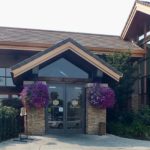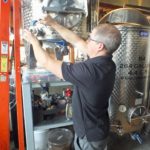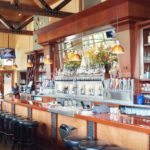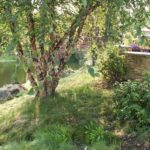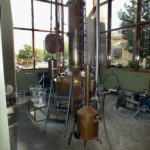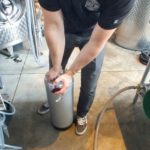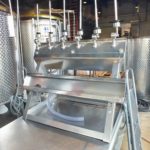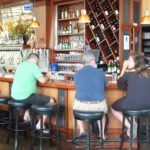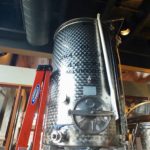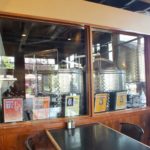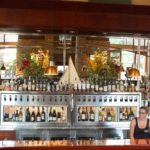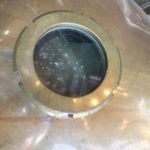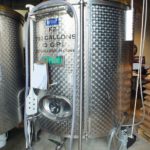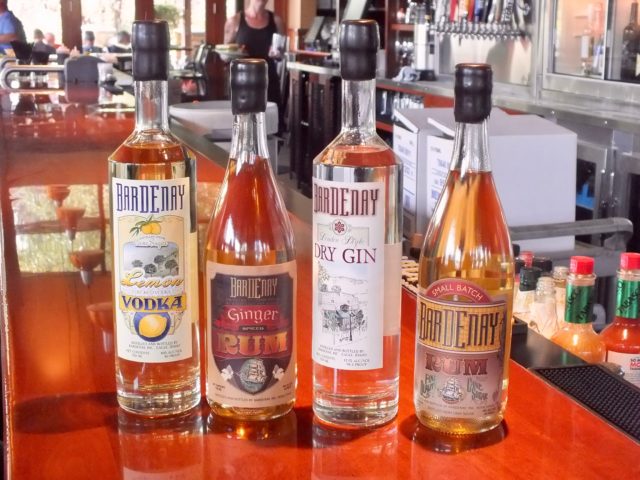
For those who love beer, there are scores of breweries in the Treasure Valley. Wineries too are common on the Sunnyslope Wine Trail. For those who appreciate the quality and taste of a carefully distilled spirit, there are much less choices. One of those started in Boise and has now expanded to both Eagle and Cour d’Alene. That is Bardenay Distillery and their quality distilled spirits are popular both in their bar/restaurants and also for people to purchase by the bottle. Scott Probert, the Head Distiller at Bardenay, recently gave me a tour of the facility and an introduction into what makes Bardenay so unique.
Before you enter Bardenay, you can look from the entrance directly at the Boise River, because Bardenay sits on its bank. As you walk into Bardenay, the first thing you notice is the long, expansive bar to the right. In front of that, tucked into its very own display windowed room, is Scott’s domain—the Bardenay Distillery. Stainless steel tanks catch your eye, but the tall gorgeous copper still is what dominates the room, forcing you to crane your neck to even see the top of it.This is where the magic happens, where various everyday ingredients are fashioned into elixirs both sweet and dry, herbaceous and fruity and plain. This is where Scott showed me what he does and allowed me to taste the fruits of his labor. And this is where Scott told me all about what he does and about Bardenay.
photo gallery follows article
Q: Scott, what makes your gin unique?
A: Number one, it’s made in a restaurant distillery. We make about 50 cases per batch, so it’s very small scale. With the botanicals, juniper is always the hallmark of every gin, and every gin is unique based upon what’s put in there. Ours also has cardamom, coriander, star anise, nutmeg and caraway seed. Something that is also unique is that we use mint and we have four different citrus components—lemon, lime, orange and grapefruit. Grapefruit is not very commonly used in gin.
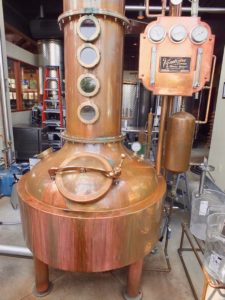
Q: How do you get the gin so smooth?
A: The build on the gin, juniper berries cardamom and coriander, those are elements that form up the attack, or that aggressive nature of gin. When you first take a sip, that’s what you get; and that’s bridged by all the sweetness, the caraway and especially the nutmeg and star anise and then certain elements of the citrus to make it kind of smooth and sweet in the middle. And then, speaking of the citrus, it’s going to give you that long finish from the acidity.
Q: So Bardenay goes back to Prohibition?
A: Bardenay was the first restaurant/distillery to be recognized post-Prohibition. We had to coordinate with the [Bureau of] ATF, now the TTB (Alcohol and Tobacco Tax Trade Bureau), and explain to them what we wanted to do. They gave us their approval. A lot of times distilleries don’t have the same allowances as breweries and wineries because of the way we’re taxed. We are taxed on the alcohol content, not on our overall volume, so we pay $13.50 per proof gallon versus a winery or brewery; they’re paying pennies on the dollar for the overall volume. There are some exceptions of course. So that being said, it was a really unique thing for the TTB to allow Bardenay Restaurant to distill on premise and then sell our products right over the wall.
Q: You have three locations, with each one specializing in a certain kind of spirit……
A: Right, that’s been a progression, because we used to make all our spirits in Downtown Boise, because that was the original location. As we’ve grown, we’ve modified our equipment to meet the needs and also the space, so our current breakdown is that in Downtown Boise we make rum and whiskey; in Eagle we make our gin, lemon vodka and liqueurs; and in Cour d’Alene Idaho they only make vodka.
Q: Liqueurs are certainly something that is unique…….
A: We currently make strawberry liqueur, banana liqueur, a cassis, and then we have some others in the works. We’re working on a pineapple liqueur as well as a cherry liqueur. Some of the unique things about them, our banana liqueur–one of my favorites—during the process, someone came back from Germany and had described having ‘banana juice’, so I had to look that up. How do you get banana juice—I’ve never really squeezed a banana and got juice out of it! The process to obtain that is similar to brewing, in that you mash the bananas in the sense that you use enzymes and ‘cook’ the bananas to a degree, essentially converting all the starches into sugars. At that point then it begins to release juice. So it started as kind of a science project and that turned into our banana liqueur. So we do mash the bananas and then we macerate the whole of the banana in alcohol and once we separate that we add sugar and the end result is beautiful. Definitely a very strong banana character, nice and sweet.
Q: The Cassis liqueur is something that is really unique…..
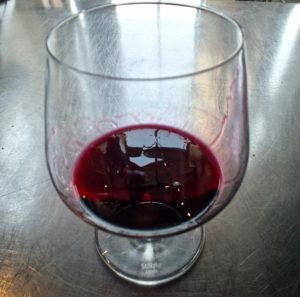
A: Cassis in the United States, to my knowledge, there aren’t any producers, at least to my knowledge. Cassis is traditionally a French product or European, mostly because of the availability of blackcurrants. Blackcurrants were banned in the United States from the early 1900’s until the early 2000’s, mostly because they felt that the blackcurrant bush was responsible for passing on blister rust to White Pine and Douglas Fir. They considered it a threat to the logging industry and so if you want to do anything, just kill everything. Seek and destroy! So it was banned in the United States from being grown commercially and so for almost a hundred years people have essentially forgotten about blackcurrants. When you have purple candy in Europe for instance it will most likely be blackcurrant while in the United States it’s going to be grape. So that being said, we found somebody that’s growing blackcurrants legally in the United States, in Oregon. We got some of the blackcurrants processed into Cassis and it’s beautiful. Because of limited availability in the United States, and especially here in Idaho, we feel that it’s the best Cassis that you can get in Idaho right now.
Q: Over here in Eagle, your two main spirits are gin and vodka. What do you feel the difference is between to two, as far as what people like in the bar?
A: The numbers say that people really like vodka in their day to day cocktails, but as far as retail sales—everything we sell off-premise—people love the gin. Usually the people who are buying our gin have a more sophisticated palate and so they’re making cocktails at home.
Q: Bardenay is very unique, being a restaurant distillery. Do your chefs tend to use the spirits in a lot of their foods?
A: They do when they can. In private, now the biggest outlet for them right now has been our liqueurs, just because they’re used to working with more whole, fresh ingredients, whereas we process everything. They use different elements from our process such as juniper berries and pork, making dishes that follow that trend with the classic vodka sauces, things like that. Most of the work that we do with the other side of the restaurant is with the bar, but we do on occasion work with the kitchen.
Q: So Bardenay is a great place to come to then…..
A: You come into Bardenay and you’re going to get good food and good drinks, a quality environment. The idea of Bardenay was to have it open to everybody and not feel like it was exclusive to money or a young crowd. We want all the people to come in. It’s great for people watching. And it’s the best martini you’re going to get for seven dollars!
So something about Bardenay……Bardenay was the name of a boat up in the San Juan’s, and so the owner, Kevin Settles was on the boat and asked ‘what does Bardenay mean?’. It’s a sailing term for cocktail hour or time for a drink.
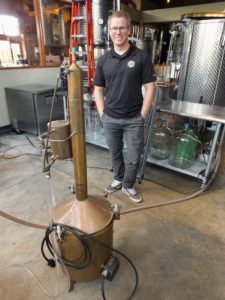
Q: Thank you, Scott, for the tour and all the interesting info about Bardenay.
The best way to find out about the different spirits and liqueurs that Bardenay distills is to go sit at the bar and try them. Try a martini, dry so you can taste the flavor of the gin. Have the bartender make you your favorite cocktail to see how smooth Bardenay’s vodka is. And try the liqueurs, savoring the sweetness and flavor that only painstaking work beginning with fresh fruits can bring about.
I was very impressed with the smoothness of the Bardenay Gin. As a gin aficionado, I found Bardenay’s Gin very sippable straight, with a nice herbaceous nose from the botanicals they use. A slight sharpness and a smooth finish yielded a nice aftertaste, making me want another sip right away.
The Cassis had a beautiful purple color, looking similar to a very thick Pinot Noir. The nose was redolent with notes of blackcurrant, aromatic and fresh. One taste was not enough—-neither was three. It was a very drinkable liqueur, perfect as an after-dinner aperitif. The Banana Liqueur had a golden hue and a nice, banana-y aroma. It would be nice to sip, and absolutely awesome on some quality French vanilla-bean ice cream. The best way to know, of course, is to try it yourself.
Tours of the Bardenay Distillery can be arranged in advance through their website. Also, if you go to Bardenay for lunch, dinner or cocktails, yoou can ask your server if someone is available to give you a tour. It truly is a fascinating insight into how our spirits and liqueurs are created.
Bardenay Distillery Eagle
155 E Riverside Dr, Eagle, ID
(208) 938-5093

